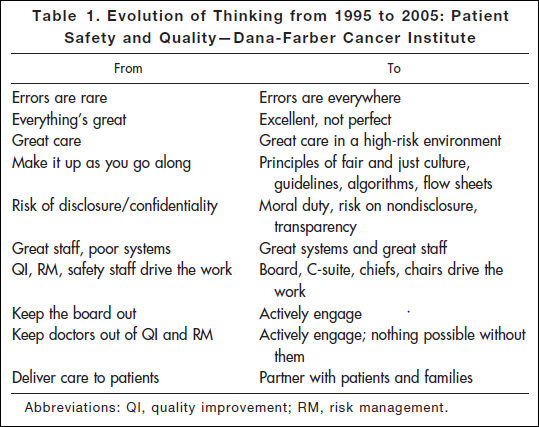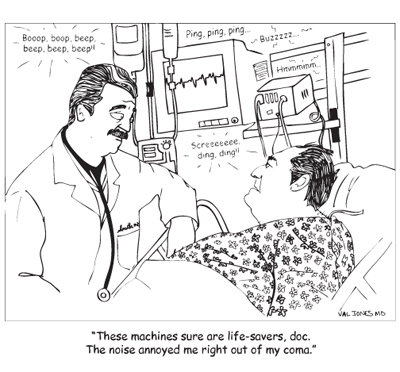January 21st, 2011 by DavedeBronkart in Health Tips, Opinion
No Comments »

There are several stages in becoming an empowered, engaged, activated patient — a capable, responsible partner in getting good care for yourself, your family, whoever you’re caring for. One ingredient is to know what to expect, so you can tell when things seem right and when they don’t.
Researching a project today, I came across an article* published in 2006: “Key Learning from the Dana-Farber Cancer Institute’s 10-Year Patient Safety Journey.” This table shows the attitude you’ll find in an organization that has realized the challenges of medicine and is dealing with them realistically:

“Errors are everywhere.” “Great care in a high-risk environment.” What kind of attitude is that? It’s accurate.
This work began after the death of Boston Globe health columnist Betsy Lehman. Long-time Bostonians will recall that she was killed in 1994 by an accidental overdose of chemo at Dana-Farber. It shocked us to realize that a savvy patient like her, in one of the best places in the world, could be killed by such an accident. But she was.
Five years later the Institute of Medicine’s report “To Err is Human” documented that such errors are in fact common — 44,000 to 98,000 a year. It hasn’t gotten better: Last November the U.S. Inspector General released new findings that 15,000 Medicare patients are killed in U.S. hospitals every month. That’s one every three minutes. Read more »
*This blog post was originally published at e-Patients.net*
December 14th, 2010 by BarbaraFicarraRN in Better Health Network, Health Tips, True Stories
1 Comment »

In a recent post I wrote why patients are the most important part of the medical team, and my colleagues, Elizabeth Cohen, Kevin Pho, MD, Donna Cryer, JD, and Carl R. Sullivan, MD, shared their insights as well. Today, Ginger Vieira, a patient living with type 1 diabetes and celiac disease, says:
“You, as the patient, are the most important part of the medical team because you are the one who makes the daily decisions, who balances your disease around dinners, soccer games, long hours at work without enough time to check your blood sugar and eat lunch. You are the one who takes the knowledge you learn from your doctor and fits it into your everyday life. That’s a huge role, and it’s never easy.”
 Ginger Vieira shares her story about the challenges and how her positive attitude is allowing her to lead a life she thought was off limits.
Ginger Vieira shares her story about the challenges and how her positive attitude is allowing her to lead a life she thought was off limits.
Contagious Confidence, Endless Possibilities
By Ginger Vieira
“Don’t let anyone tell you that you can’t do something.” My twin brother, Pete, said this to me several months ago. I wrote it down on an index card and taped it to my bathroom mirror. Funny thing is, it’s never been other people telling me I can or cannot do something. The loudest voice I hear is my own.
When I was diagnosed with type 1 diabetes in the seventh grade over eleven years ago, the first list that ran through my head was the list of things I probably couldn’t do anymore. I couldn’t eat ice cream without first counting the grams of carbohydrates in the bowl and determining how much insulin I needed. I couldn’t play basketball anymore (at least, that’s what I thought). I couldn’t buy candy and popcorn with my friends when we go to the movies without feeling overwhelmingly guilty about eating such diabetic-off-limits food. The list of foods, activities, dreams and goals I thought were off-limits seemed endless. Read more »
*This blog post was originally published at Health in 30*





 Ginger Vieira shares her story about the challenges and how her positive attitude is allowing her to lead a life she thought was off limits.
Ginger Vieira shares her story about the challenges and how her positive attitude is allowing her to lead a life she thought was off limits.







